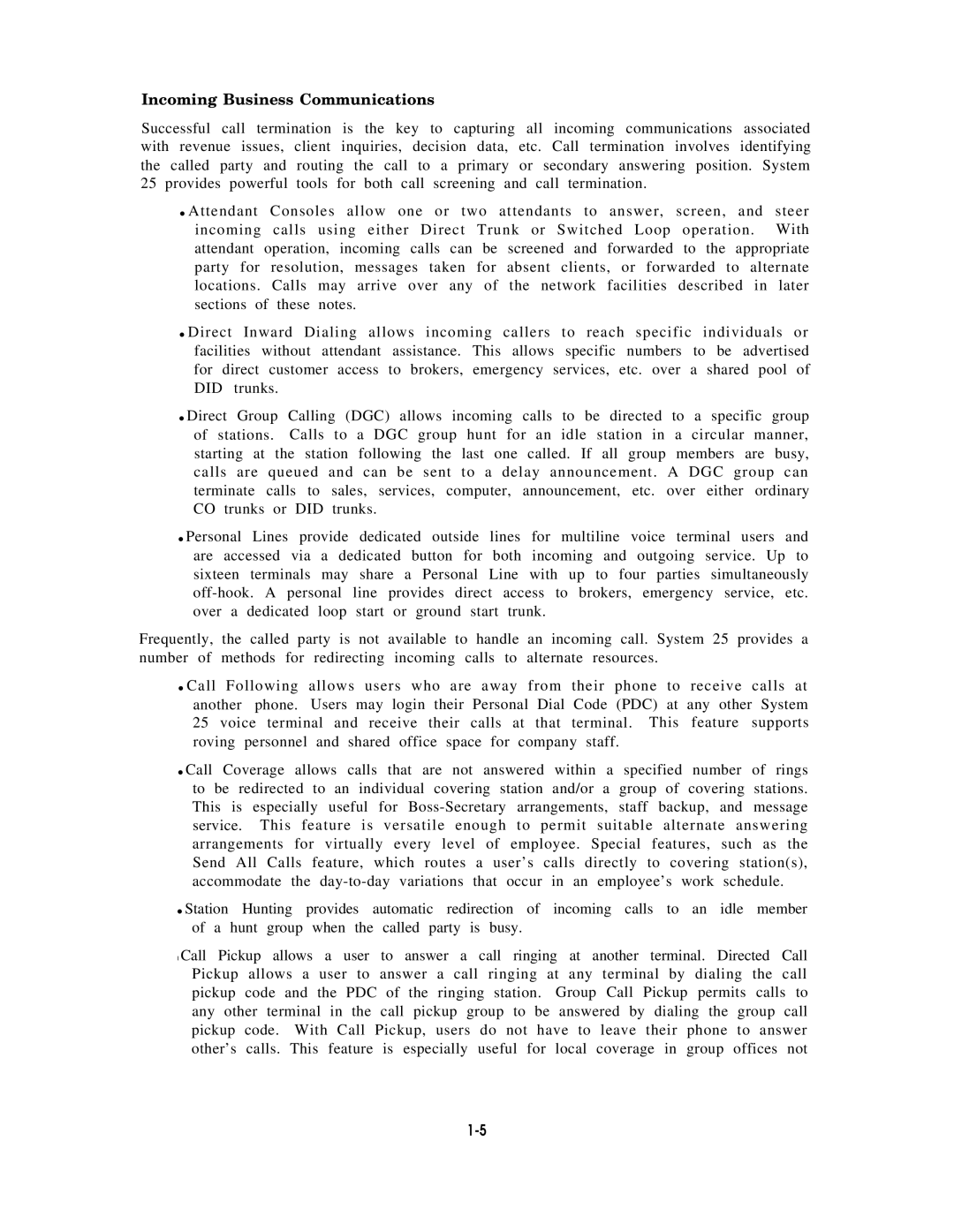Incoming Business Communications |
|
| ||||
Successful call termination is the key | to | capturing | all incoming communications associated | |||
with | revenue issues, | client inquiries, | decision data, | etc. Call termination involves identifying | ||
the | called party and | routing the call | to | a | primary | or secondary answering position. System |
25 provides powerful | tools for both call | screening and call termination. | ||||
●Attendant Consoles allow one or two attendants to answer, screen, and steer incoming calls using either Direct Trunk or Switched Loop operation. With attendant operation, incoming calls can be screened and forwarded to the appropriate party for resolution, messages taken for absent clients, or forwarded to alternate locations. Calls may arrive over any of the network facilities described in later sections of these notes.
●Direct Inward Dialing allows incoming callers to reach specific individuals or
facilities without attendant assistance. This allows | specific numbers | to | be advertised | |||
for direct customer access to brokers, emergency services, etc. over | a | shared pool of | ||||
DID | trunks. |
|
|
|
|
|
● Direct | Group | Calling (DGC) allows incoming calls | to be directed | to | a | specific group |
of stations. | Calls to a DGC group hunt for an | idle station in | a | circular manner, | ||
starting at the station following the last one called. If all group members are busy, calls are queued and can be sent to a delay announcement. A DGC group can
terminate | calls to | sales, services, computer, | announcement, | etc. | over either ordinary | |
CO trunks | or | DID | trunks. |
|
|
|
● Personal Lines | provide dedicated outside lines | for multiline | voice | terminal users and | ||
are accessed via a dedicated button for both incoming and outgoing service. Up to sixteen terminals may share a Personal Line with up to four parties simultaneously
Frequently, the called party is not available to handle an incoming call. System 25 provides a number of methods for redirecting incoming calls to alternate resources.
●Call Following allows users who are away from their phone to receive calls at another phone. Users may login their Personal Dial Code (PDC) at any other System 25 voice terminal and receive their calls at that terminal. This feature supports
roving personnel and shared office space for company staff.
● Call | Coverage allows calls that are not answered | within | a | specified | number | of rings |
to | be redirected to an individual covering station | and/or | a | group of | covering | stations. |
This is especially useful for
accommodate the | in an employee’s work schedule. | ||||||||||||
● Station | Hunting | provides automatic | redirection of | incoming calls to | an | idle | member | ||||||
of | a hunt | group | when the | called party is busy. |
|
|
|
|
| ||||
l Call | Pickup | allows | a | user | to answer a call ringing at another | terminal. | Directed Call | ||||||
Pickup allows a user to answer a call ringing | at any terminal by dialing the call | ||||||||||||
pickup | code and | the | PDC | of the | ringing station. | Group Call | Pickup | permits | calls to | ||||
any other terminal in the call pickup group to be answered by dialing the group call pickup code. With Call Pickup, users do not have to leave their phone to answer other’s calls. This feature is especially useful for local coverage in group offices not
